Ireland from the U.K. to Republic
By no means did all people living in Ireland want Home Rule for Ireland. In 1912, a group of Unionists announced that September 28 was Ulster Day. Ulster, long a Protestant stronghold and home to many English landowners, was the setting for a public signing of the Solemn League and Covenant, a petition to oppose Irish self-rule. More than 440,000 people signed the petition. Also in 1912, a group of 100,000 marched near Belfast to demonstrate solidarity with the U.K. 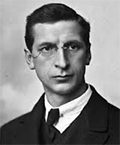
Into the fray in the 1918 general election stepped Sinn Féin, then led by Éamon de Valera (right), one of those imprisoned for his part in the Easter Rising. (The U.K. Government had released most of those imprisoned, in late 1916 and in 1917). Members of Sinn Fein won 73 seats in the U.K. Parliament but did not take their seats in Westminster; rather, they gathered in the Dublin Mansion House in January 1919 as the Dáil Éireann, or Assembly of Eire. The newly declared Irish Republic also had a military protection unit, the Irish Republican Army. The government in Westminster outlawed both the Dáil Éireann and Sinn Féin, and U.K. troops patrolled the streets. The IRA claimed membership of about 70,000. The U.K. police presence in Ireland at this time was about 50,000, far more than in England. A guerrilla war followed, with Irish republicans carrying out acts of targeted violence, such as destroying property owned by the U.K. government or its military forces and even killing top U.K. government officials. U.K. soldiers carried out raids on civilian households and making hundreds of arrests of suspected military leaders. In one high-profile case, a group suspected of being employed by the U.K. military gunned down Tomás Mac Curtain, the Lord Mayor of Cork and a member of Sinn Féin; the resulting jury trial delivered a verdict of guilty for not only the suspects but also then-U.K. Prime Minister David Lloyd George. During this time, the British Army had help from the Black and Tans, an auxiliary security force assigned to the Royal Irish Constabulary to help keep the peace. Many of the Black and Tans (the name coming from the colors of the uniforms they wore) were veterans of World War I. They became known for attacks on civilians. 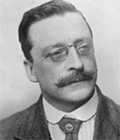
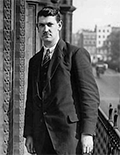
Sinn Féin founder Arthur Griffith (left) continued to call for civil disobedience, and these included work stoppages and refusing to sell food and other goods to members of the U.K. military. Many Irish republicans who worked for the railroads made their mark at this time by refusing to transport British troops or their supplies. In 1920, Irish people in droves stopped showing up for jury duty. They also stopped paying taxes to the U.K. Many people at this time gave money to the National Loan, set up by republican leader Michael Collins (right) to help fund the Dáil Éireann and Sinn Féin. Another way in which republicans exercised civil disobedience was to go on hunger strike if imprisoned. One of those who died as a result of a hunger strike was the new Lord Mayor of Cork, Terence MacSwiney. In late 1920, the violence escalated, and U.K. forces placed several locales under martial law. It was in November 1920 that one of the most well-known series of events in modern Irish history occurred. 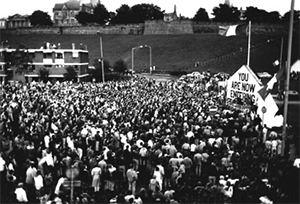
On November 11 in Dublin, 32 people on both sides of the conflict died. It began in the morning, when an armed gang organized by Michael Collins killed 15 people, 12 members of the U.K. military force and three civilians. (The official target of the operation were members of the Cairo Gang, a group of undercover U.K. inteligence agents.) In response, U.K. soldiers went to a Gaelic football match in Croke Park and fired into the crowd, killing 14 people and wounding five dozen others. The troops kept shooting for 90 seconds, even as the crowd gathered and it was clear that none of them were armed. The day ended with the killing of three people who were being held in Dublin Castle; the story from their captors was that the prisoners were attempting to escape. November 11 became known as Bloody Sunday. The U.K. Government in 1920 had introduced another Home Rule bill, one that was slightly different from the one passed in 1914 but never brought into being. The Government of Ireland Act 1920 partitioned Ireland in two, with the 26 southern counties being one entity represented by its own parliament and the six northern counties being another entity represented by its own parliament; in addition, each of the two parliaments was to send 20 members to form a Council of Ireland. Neither group in Ireland was satisfied with the bill, and the violence continued. Renewed violence shattered the brief truce following Bloody Sunday, and another 1,000 people died in the next few months. A truce in July 1921 held, and the hard political negotiating began. U.K. Prime Minister David Lloyd George and republican leader Éamon de Valera hammered out an agreement that saw both sides agree to put down their weapons until an accord could be reached. 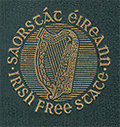
Negotiations stalled, and some in Ireland on both sides of the divide took the opportunity to resume random acts of violence. However, the Anglo-Irish Treaty of Dec. 6, 1921, ended the fighting and paved the way for the Irish Free State. It wasn't an immediate transition. Although Collins and Griffith had been among the negotiators, de Valera refused to abide by the terms of the treaty and tried to convince the Dáil to nullify it. After failing in this effort, de Valera resigned as Dáil president and found himself succeeded by Griffith. Meanwhile, James Craig, leader of the Ulster Unionist Party, had become the first Prime Minister of Northern Ireland. The Anglo-Irish Treaty had included a provision for the six northern counties of Ireland to opt out of joining the Irish Free State, and they had done so. The new Irish Free State was a constitutional monarchy, with a Governor-General representing the U.K. crown and the government having two houses, the Dáil Éireann, or lower house, and the Seanad Éireann, or upper house. The equivalent of a prime minister was the President of the Executive Council. The first to hold that title was W.T. Cosgrave, who taken up the republic mantle after the deaths of both Collins and Griffith in 1922. 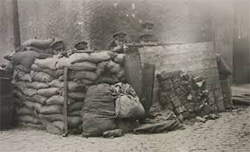
The split in the republican movement stretched much further than at the top. Many in the Irish Republican Army wanted much more independence than the 1921 treaty had granted them. The Dáil Éireann had only narrowly approved the treaty. Public opinion in the wider populace was split as well. A general election in 1922 reflected this split as well, with pro-treaty forces winning a slight majority of the votes. The split descended into armed conflict, and southern Ireland was consumed for more than a year by civil war, which had some of the same elements of the struggle against U.K. rule, including guerrilla warfare, assassination of leading officials. Pro-treaty forces had the upper hand militarily and forced the anti-treaty forces to bargaining table in 1923. The north of the island refrained from getting involved and was able to solidify itself as an independent entity. Pro-treaty forces formed the political party Cumann na nGaedheal in 1923. This party had a majority in the Dáil for four years, during which time Sinn Fëin refused to take their seats. De Valera resigned from Sinn Fëin in 1926 and formed a new political party, Fianna Fáil. After the 1927 general election, this party agreed to sit in the Dáil. The U.K. Statute of Westminster 1931 had effectively given the Irish Free State Dominion status and more of a free hand in running its own affairs. The 1932 general election resulted in a Fianna Fáil majority in the Dáil and de Valera's being named President of the Executive Council. 
The Cumann na nGaedheal government had passed a Coinage Act in 1926 and a Currency Act in 1927, creating Free State coinage in the form of the Saorstát pound. De Valera went further in 1932, abolishing the Oath of Allegiance to the Crown and also doing away with the Senate and appeals to the U.K. Privy Council. The Fianna Fáil government unveiled a new constitution to the Dáil in 1937. Voters approved the constitution and returned the government to office on the same day, July 1. The new Constitution of Ireland went into effect on Dec. 29, 1937 and created a new state called Éire, or Ireland, with a President heading up the government. The first President was Gaelic League founder Douglas Hyde. First page > From Consolidation through Dark Times > Page 1, 2, 3 |
|
Social Studies for Kids
copyright 2002–2025
David White





